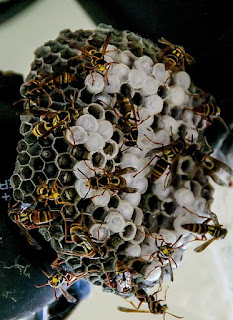Things with Stings Smarter than you Knew
As I write this in early October, autumn chill and rain are in the upstate New York air. Wasps are more active. Yellowjackets are the most aggressive of wasps, and they will sting more than once just because. Avoid hornets, they are a kind of wasp but their stings pack a greater punch — especially for people who are allergic to them. If you see a nest in your building, consider calling for professional removal because angering a few thousand can spoil your day.
 |
| Paper wasp nest (I simplify it to "wassness"), Pixabay / sandid |
Wasps (Family Vespidae) have a bad rap, but their benefits actually outweigh their painful sting—although many would disagree!What is the function of these creatures? To begin with, they’re more interested in attacking insect pests than you, and they pollinate plants. Entomologists have discovered powerful antibiotics in their venom, and there is also an indication the venom may be used as a possible cancer treatment.One of the many kinds of wasps is the paper wasp (Genus Polistes), known for gathering fibrous material from plant stems and dead wood. Mixing the plant product with their saliva, they make a virtual paper nest. These wasps were chosen to be used in a recent study regarding—of all things—abstract interrelationships.
The rest of the article is at "Brainy Paper Wasps."